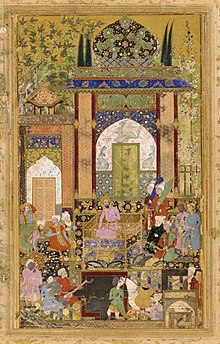Miniature Art
Miniature as the name suggests are small-scale, highly detailed paintings. They trace back to at least 9th century CE, and are living tradition with many contemporary artists still pursuing the art form. Miniature art is an intense labour of love illustrated on a range of materials like palm leaves, paper, wood, marble, ivory panels and even cloth. The common themes of these paintings are mythological and religious texts though it differs from every artist. One of the outstanding features of these paintings is the intricate brushwork which contributes to their unique identity. The colours used in these paintings are derived from various natural sources like vegetables, indigo, precious stones, silver and even gold.
Miniature paintings originated in India around 750 A.D. when Palas ruled over the eastern part of India. Since religious teachings of Buddha, accompanied by his images, were written on palm leaves, these paintings became popular. These paintings originated not as independent pieces but rather as narratives or illustrations for manuscripts or books. The tradition bloomed primarily as a means to reveal the divine. It gained momentum with Vaishnavism's revival and the Bhakti Movement's growth in the 18th century. Devotional literature like Gita Govinda, Bhagvat Purana and Surasaga became the source of the source of inspiration for the Indian artists. Even the paintings commissioned by Hindu princely courts were an act of respecting the sacred scriptures and religious epics. Eventually, there was some external influence as well.
While Buddhism in the East, it was Jainism that inspired the miniature artistic movement of the Western Indian style of miniature painting. This prevailed in the regions of Rajasthan, Gujrat and Malwa from the 12th -16th century A.D. Jain manuscripts were illustrated using exaggerated physical traits, vigorous lines and bold colours. With the advent of Persian influence in the 15th century, paper replaced palm leaves, while hunting scenes and varied facial types started appearing along with the use of rich aquamarine blues and gold.
Miniature paintings in Jain manuscripts
The amalgamation of Indian paintings and Persian miniature paintings gave rise to Mughal miniature paintings. Interestingly, Persian miniature paintings were somehow influenced by Chinese paintings. Mughal Paintings and artists flourished under the reign of Emperor Akbar. When Humayun, the second Emperor of Mughal Empire was on exile in Persia he was exposed to Persian miniature paintings. He brought two accomplished Persian artists to India “Ade-al-Samad” and “Mir Sayyid Ali”. Humayun’s major commission was Khasmsa of Nizami , which is collection of 36 illuminated pages with art styles of various artists. Shah Jahan was one of the Mughal emperors who spent an incalculable amount of money on architecture, gardens, jewelry, and paintings. Shah Jahan’s miniature portrait is just one of the several artworks that portrayed cultural hybridity.
These miniature paintings were brought to life keeping in mind of the minute details, and harmony of colours and patterns that made the paintings stand out. The world of miniature Paintings is a kaleidoscope of history, scriptures and the lives of people through the ages.
~Nabamita Sarkar






Comments
Post a Comment